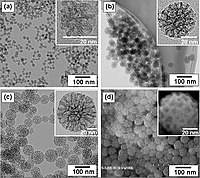
Photo from wikipedia
Abstract A facile method for making porous SiC ceramics from sawdust avoiding high-temperature liquid or vapor phase silicon infiltration has been outlined. Cylindrical bodies prepared by hand pressing of aqueous… Click to show full abstract
Abstract A facile method for making porous SiC ceramics from sawdust avoiding high-temperature liquid or vapor phase silicon infiltration has been outlined. Cylindrical bodies prepared by hand pressing of aqueous pastes produced from sawdust, silicon powder, sucrose, and sintering additives are subjected to freeze-drying followed by carbonization and ceramization heat-treatments to produce porous SiC. The carbon-silicon reaction is completed at a minimum temperature of 1550 °C as verified from TGA and XRD analysis. The SiC produced from sawdust particles is firmly held together by the sucrose-derived SiC. The pore channels inherited in the sawdust particle remain in the SiC ceramics. A large population of nanowires is observed throughout the sucrose-derived SiC as well as on the pore channel surfaces of SiC formed from sawdust particles. The porosity decreases from ∼88 to 75 vol%, the compressive strength rises from 0.5 to 12.5 MPa, and thermal conductivity rises from 0.23 to 0.98 W/mK when the sucrose to sawdust weight ratio rises from 0.5 to 2.5. The reflection contribution (1.9–3 dB) to the total EMI shielding effectiveness (16 To 31 dB) of the porous SiC ceramics is very low compared to the absorption contribution (15–28 dB). The carbonized bodies are amenable to machinating enabling the production of near-net-shape before ceramization. The presence of large excess of silicon observed in biomorphic SiC made by molten liquid infiltration is avoided in this method.
Journal Title: Ceramics International
Year Published: 2021
Link to full text (if available)
Share on Social Media: Sign Up to like & get
recommendations!